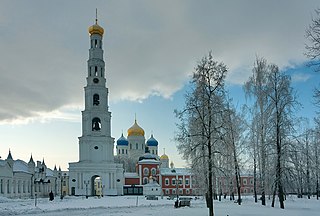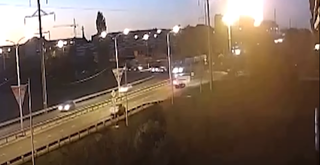
The White House (also known as the Demidov Manor House) is a noted historical building in Kyshtym. The grand Palladian townhouse with two lateral towers is set on a hill in a fenced park. It is featured in Kyshtym's city emblem.

The White House (also known as the Demidov Manor House) is a noted historical building in Kyshtym. The grand Palladian townhouse with two lateral towers is set on a hill in a fenced park. It is featured in Kyshtym's city emblem.
The original house on the grounds of the Kyshtym iron works was built by Nikita Demidov's son Nikita in the mid-18th century. The current Empire style edifice was constructed in the early 19th century by the plant's next owner, Lev Rastorguyev (who also owned the immense Rastorguyev Palace in Yekaterinburg). The architect was Mikhail Pavlovich Malakhov.
Since the late 19th century the palace has housed a local museum with a choice array of mineral exhibits. During World War II the Herzen University was relocated from Leningrad to Kyshtym, with the White House serving as the main campus building. The palace is urgently in need of upkeep and repair.
In August 2021, the reconstruction project of the White House was included in the state program of the Ministry of Culture of the Russian Federation. [1] In 2022, the reconstruction of the White House began. [2] [3] After the renovation museum of Demidov breeders is planned to open in the building. [1]

Yekaterinburg is a city and the administrative centre of Sverdlovsk Oblast and the Ural Federal District, Russia. The city is located on the Iset River between the Volga-Ural region and Siberia, with a population of roughly 1.5 million residents, up to 2.2 million residents in the urban agglomeration. Yekaterinburg is the fourth-largest city in Russia, the largest city in the Ural Federal District, and one of Russia's main cultural and industrial centres. Yekaterinburg has been dubbed the "Third capital of Russia", as it is ranked third by the size of its economy, culture, transportation and tourism.

The White House, also known as the Russian White House and previously known as the House of Soviets of Russia, is a government building in Moscow. It stands on the Krasnopresnenskaya Embankment. The building serves as the primary office of the government of Russia and is the official workplace of the Russian Prime Minister.

Moscow Domodedovo International Airport, formally Domodedovo Mikhail Lomonosov International Airport, is an international airport serving Moscow, the capital of Russia. It is located in Domodedovo, Moscow Oblast, 42 kilometres (26 mi) south-southeast from the city centre of Moscow. Domodedovo Airport serves regular flights across Russia, as well as to Asia, Africa, and the Middle East, and it is the third largest airport in Russia and the CIS after Sheremetyevo and Pulkovo. Domodedovo Airport is among the top twenty busiest airports in Europe. In 2022, the airport served 21.2 million passengers.

Pushkin is a municipal town in Pushkinsky District of the federal city of St. Petersburg, Russia, located 24 kilometers (15 mi) south from the center of St. Petersburg proper, and its railway station, Tsarskoye Selo, is directly connected by railway to the Vitebsky Rail Terminal of the city. Population: 92,889 (2010 Census).

Sergiyev Posad is a city that is the administrative center of Sergiyevo-Posadsky District in Moscow Oblast, Russia. Population: 111,179 (2010 Census); 113,581 (2002 Census); 114,696 (1989 Soviet census).

Lubyanka is the popular name for the building which contains the headquarters of the FSB on Lubyanka Square in the Meshchansky District of Moscow, Russia. It is a large Neo-Baroque building with a facade of yellow brick designed by Alexander V. Ivanov in 1897 and augmented by Aleksey Shchusev from 1940 to 1947. It was previously the national headquarters of the KGB. Soviet hammer and sickles can be seen on the building's facade.

The Leaning Tower of Nevyansk is a tower built in the 18th century located within the town of Nevyansk, Sverdlovsk Oblast, Russia. The construction was funded by the blacksmith and industrialist Nikita Demidov and later his son Akinfiy Demidov, a famous Russian manufacturer and associate of Peter I. However, the architect is not presently known.

Kyshtym is a town in Chelyabinsk Oblast, Russia, located on the eastern slopes of the Southern Ural Mountains 90 kilometers (56 mi) northwest of Chelyabinsk, near the town of Ozyorsk. Population: 38,942 (2010 Census); 41,929 (2002 Census); 42,852 (1989 Soviet census); 36,000 (1970).

The Russian Revival style comprises a number of different movements within Russian architecture that arose in the second quarter of the 19th century and was an eclectic melding of Byzantine elements and pre-Petrine architecture.

Nikolo-Ugreshsky Monastery is a walled stauropegic Russian Orthodox monastery of St. Nicholas the Miracle-Worker located in a suburb of Moscow, Dzerzhinsky. It is the town's main landmark and is featured on the city emblem.

The Flag of the Russian Empire or Black-yellow-white flag was the official flag of the Russian Empire from 11 June 1858 to 29 April 1896, when Emperor Nicholas II declared the white-blue-red flag national, but the black-yellow-white flag was not officially abolished. Formally, its use extended to government agencies, administrative and state buildings, while individuals could only raise white-blue-red flags.

Chelyabinsk State University is a public university in Chelyabinsk, Russia. It was established in 1976 and is considered to be one of the leading academic institutions in the Ural region. Member of Association of Classical Universities of Russia and Eurasian Association of Universities.

Malaya Sadovaya Street is a pedestrian street of cafes, terraces and fountains in the heart of Saint Petersburg, Russia. It runs between Italyanskaya Street and the Nevsky Prospect. Spanning a single block, at about 175 metres (574 ft), it is known as Saint Petersburg's shortest street.
Oleg Andreyevich Gusev is a Russian entrepreneur and politician from Urals. He is currently the head of Ural Financial Holding enterprise, based in Ekaterinburg, and involved in massive land development projects and other large businesses. Formerly he also was a member of regional government ranking up to vice prime minister.

The Spit of Nizhny Novgorod is one of the main natural landmarks in the historical centre of Nizhny Novgorod. It is located at the confluence of the Oka and Volga rivers.
The Tuvardzhiyev House was a one-and-a-half-storey historical building in Rostov-on-Don. It was located at 41 Shaumyana Street. Constructed in the late nineteenth century, it was an example of a typical merchant house of this period, and was the location of the city's first billiard room. Despite efforts to secure its preservation, the house was demolished in 2016.

The Fontanka Embankment is a street in Saint Petersburg that follows the course of the Fontanka from its origin as it diverges from the Neva River up to its confluence with the Great Neva. In 1762–1769 the general plan of city development was developed by the State Special Committee, headed by Aleksei Kvasov. Following this plan, in the 1780s the shores were embanked in granite by architect Giacomo Quarenghi. The Fontanka Embankment was used as a border of Saint Petersburg central part.

On the evening of 17 October 2022, a Su-34 military aircraft crashed into an apartment building in Yeysk, Krasnodar Krai, Russia.

The Pikul housein Severodvinsk is a wooden two-story building at the intersection of Industrialnaya and Polyarnaya streets. The house is famous for the fact that future famous Soviet writer Valentin Savvich Pikul lived in it in 1940–1941.

Estates in Russian architecture are typically a settlement complex of residential, household, parks and other buildings, as well as a manicured garden. Estates first appear in the 15th century in the Principality of Moscow and are associated with the estate system.